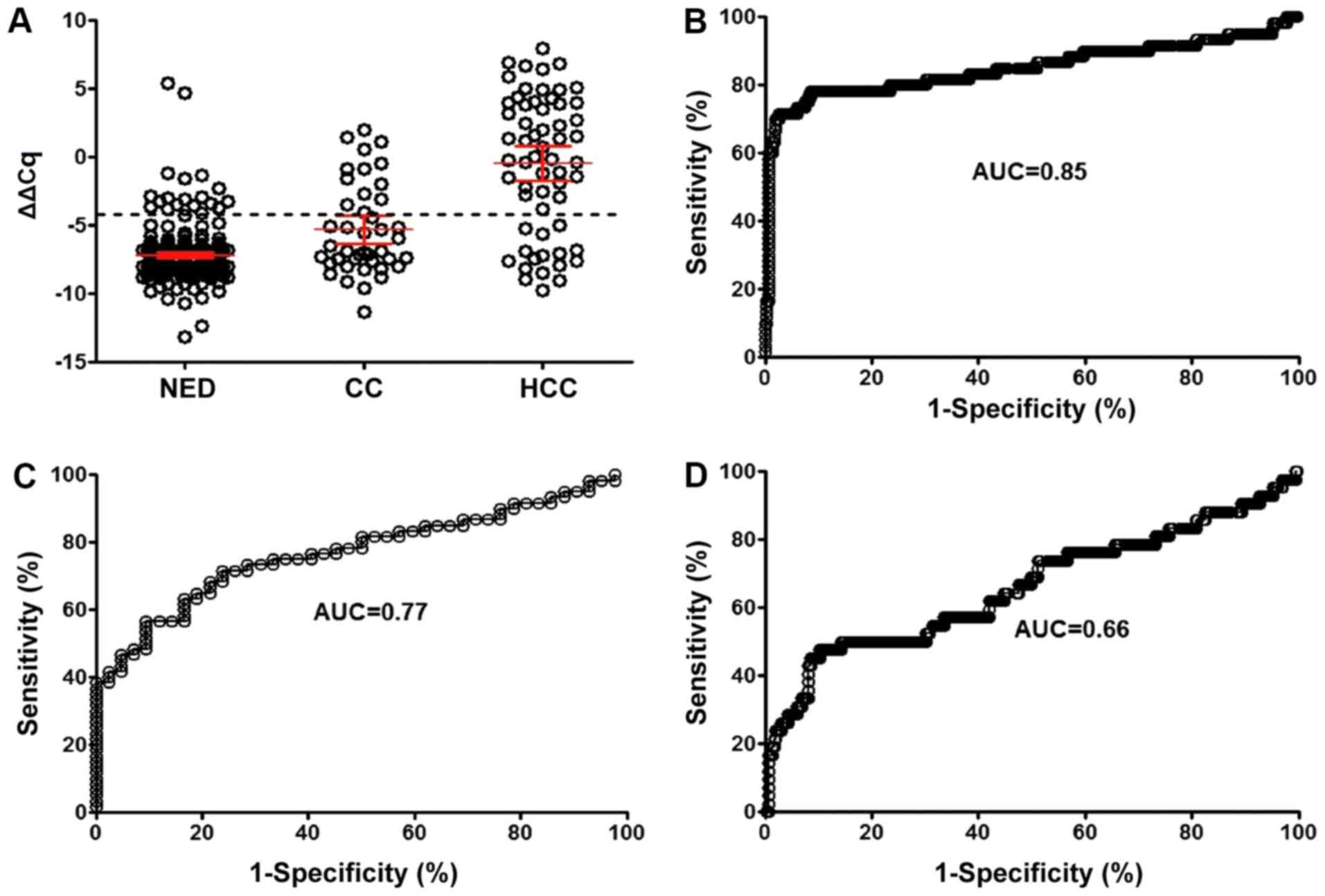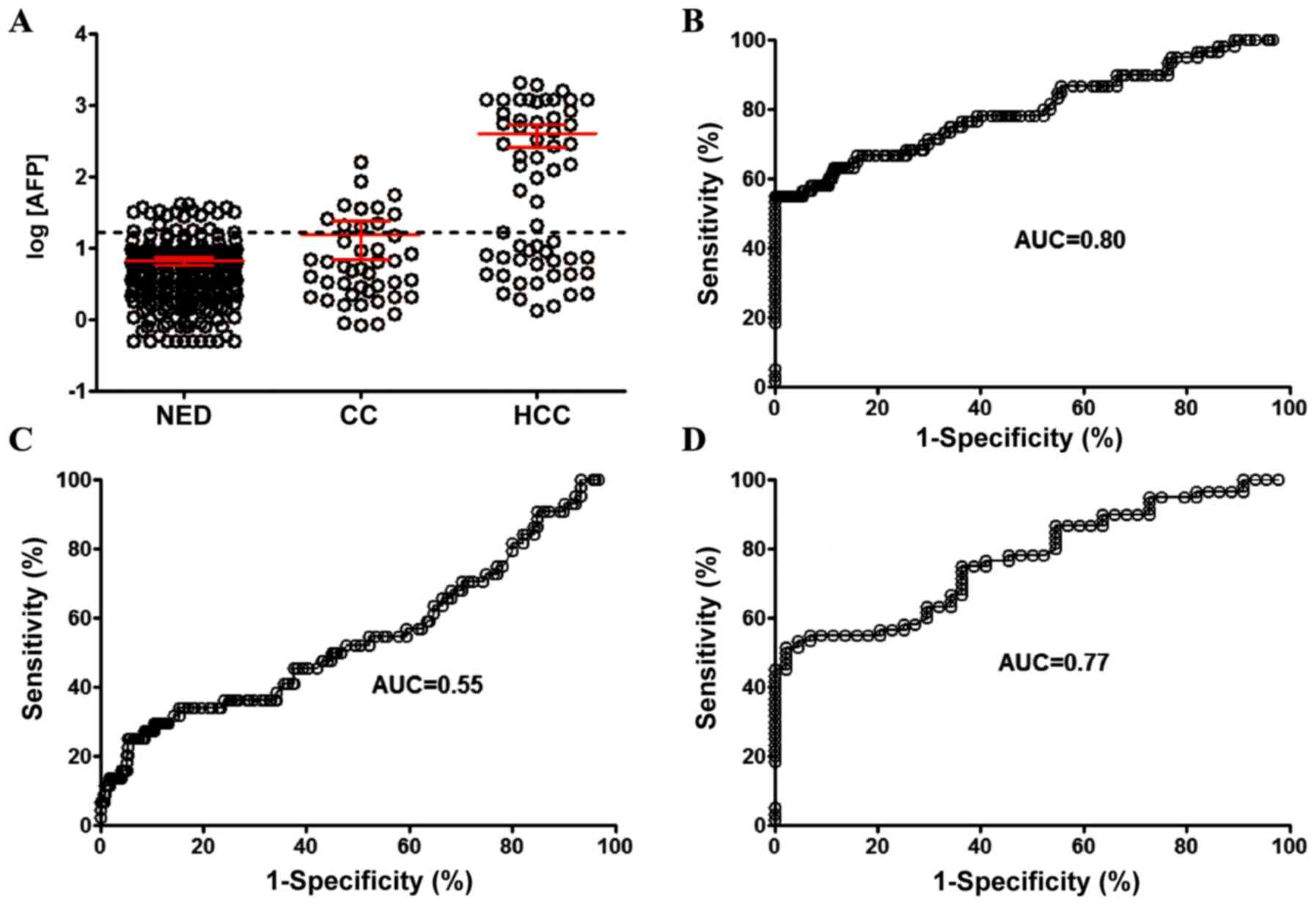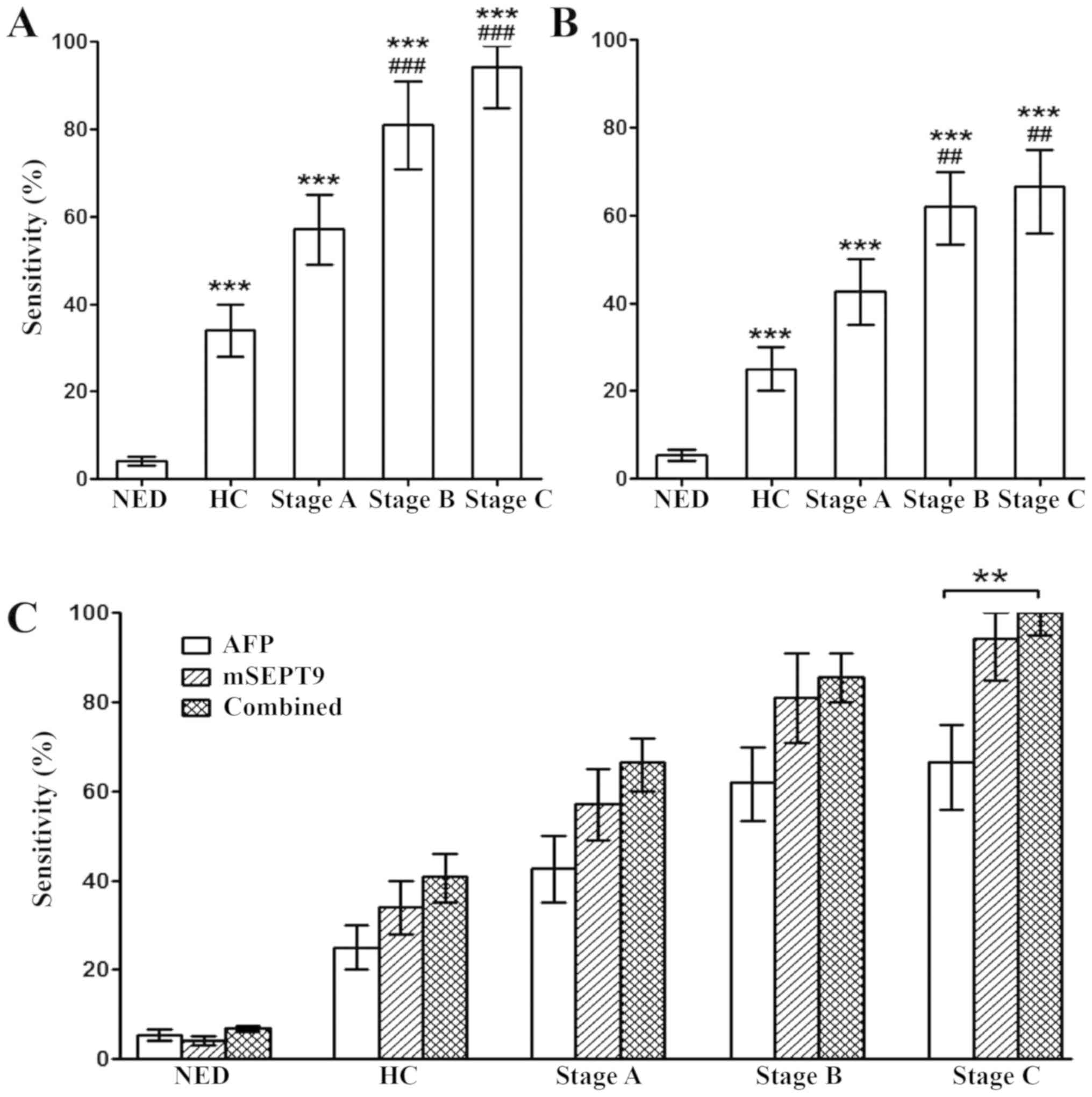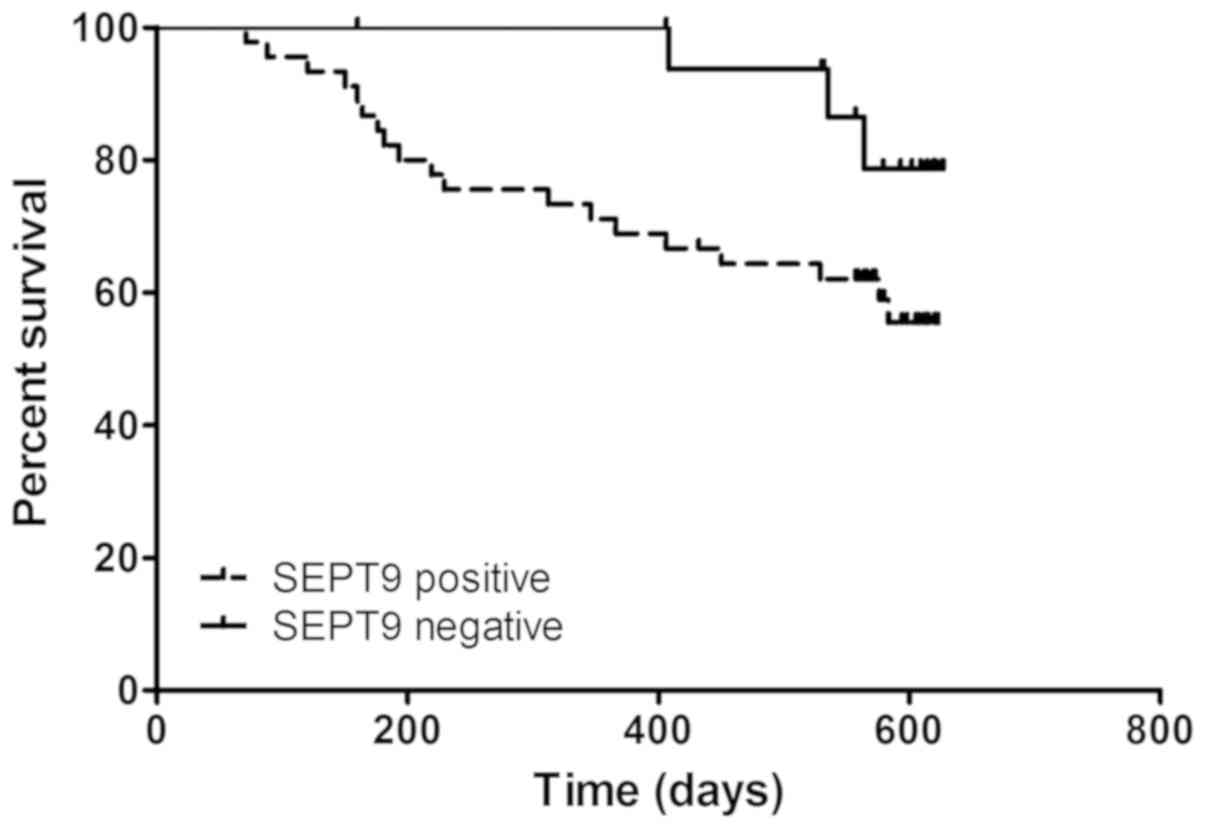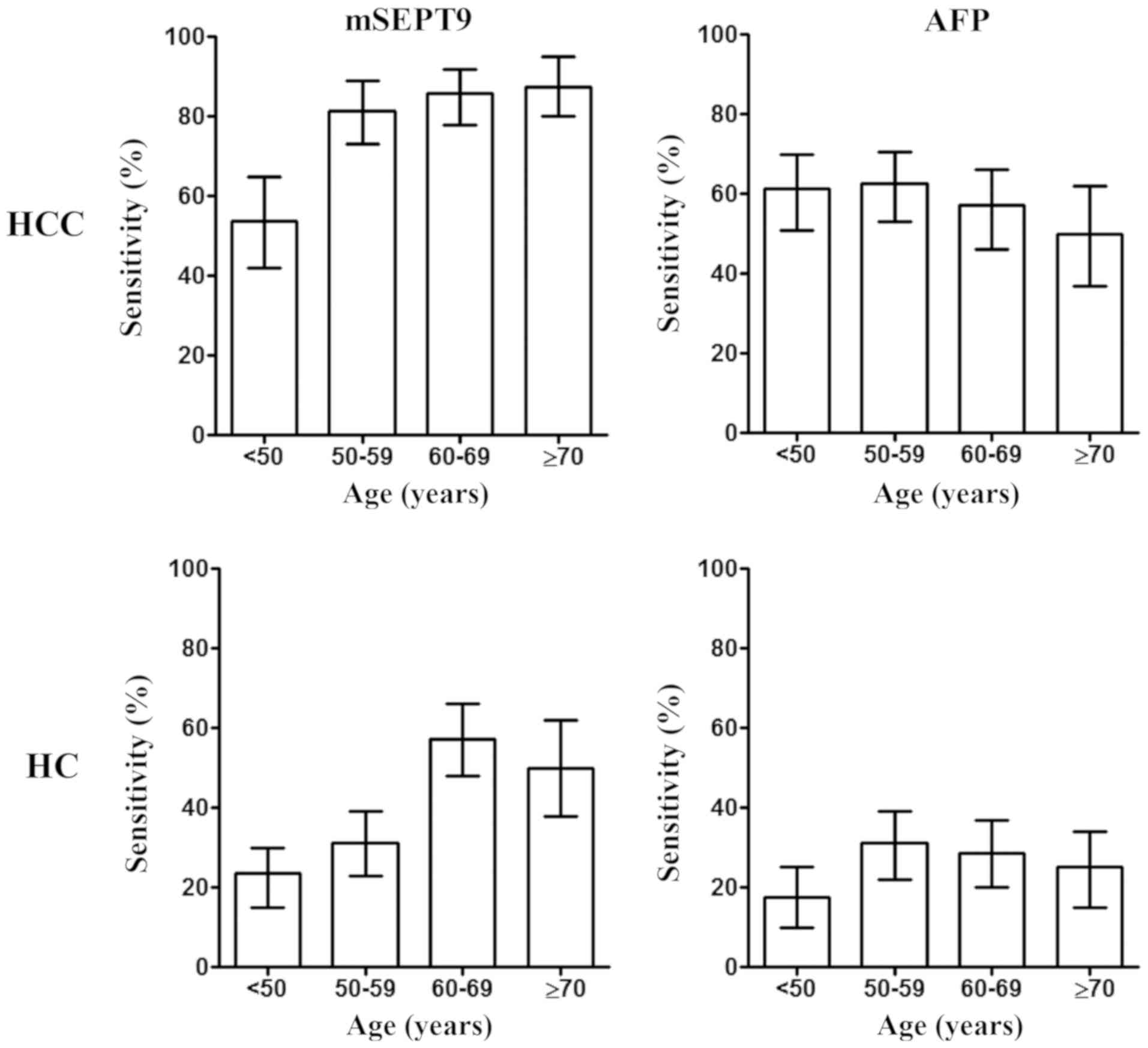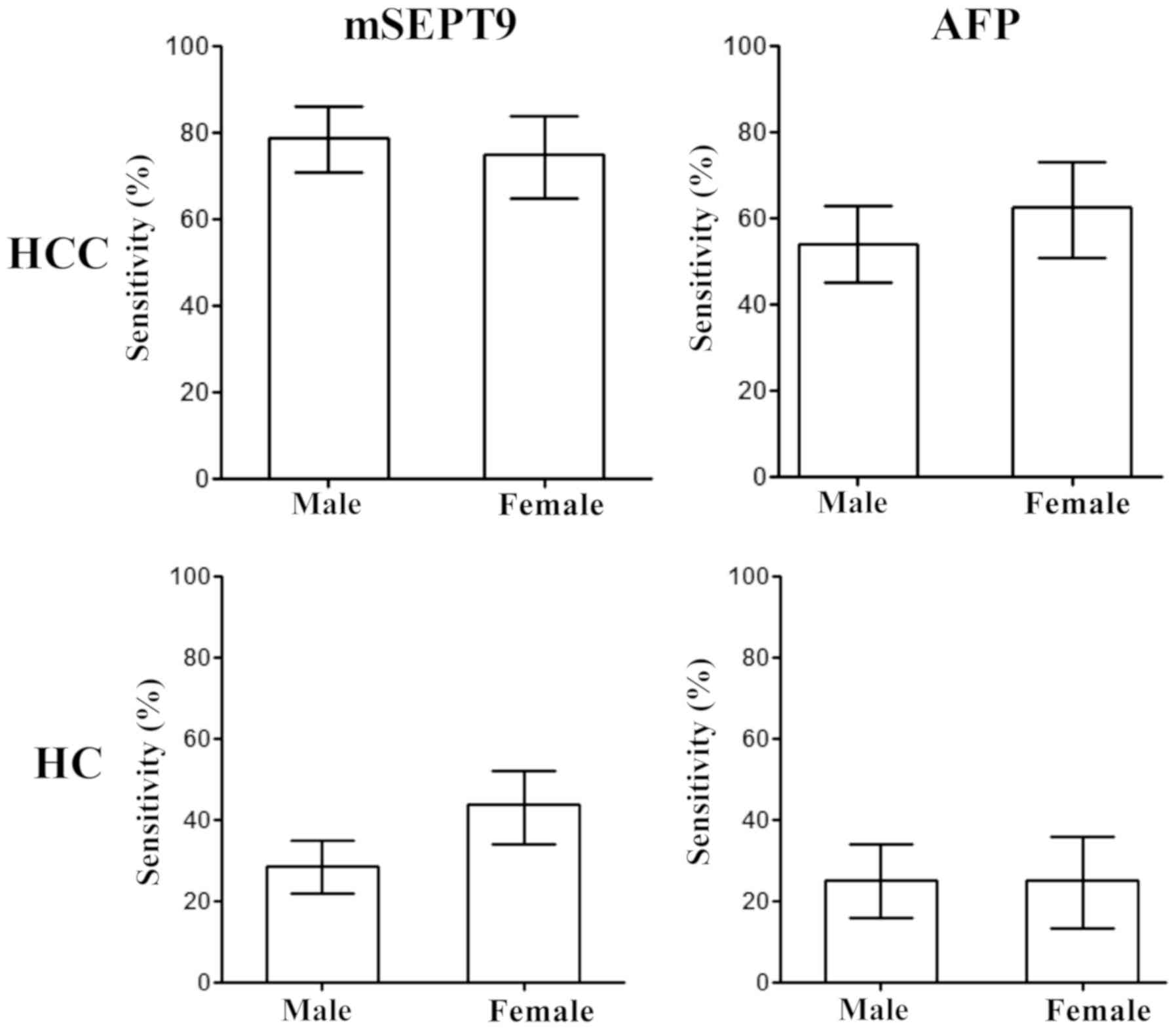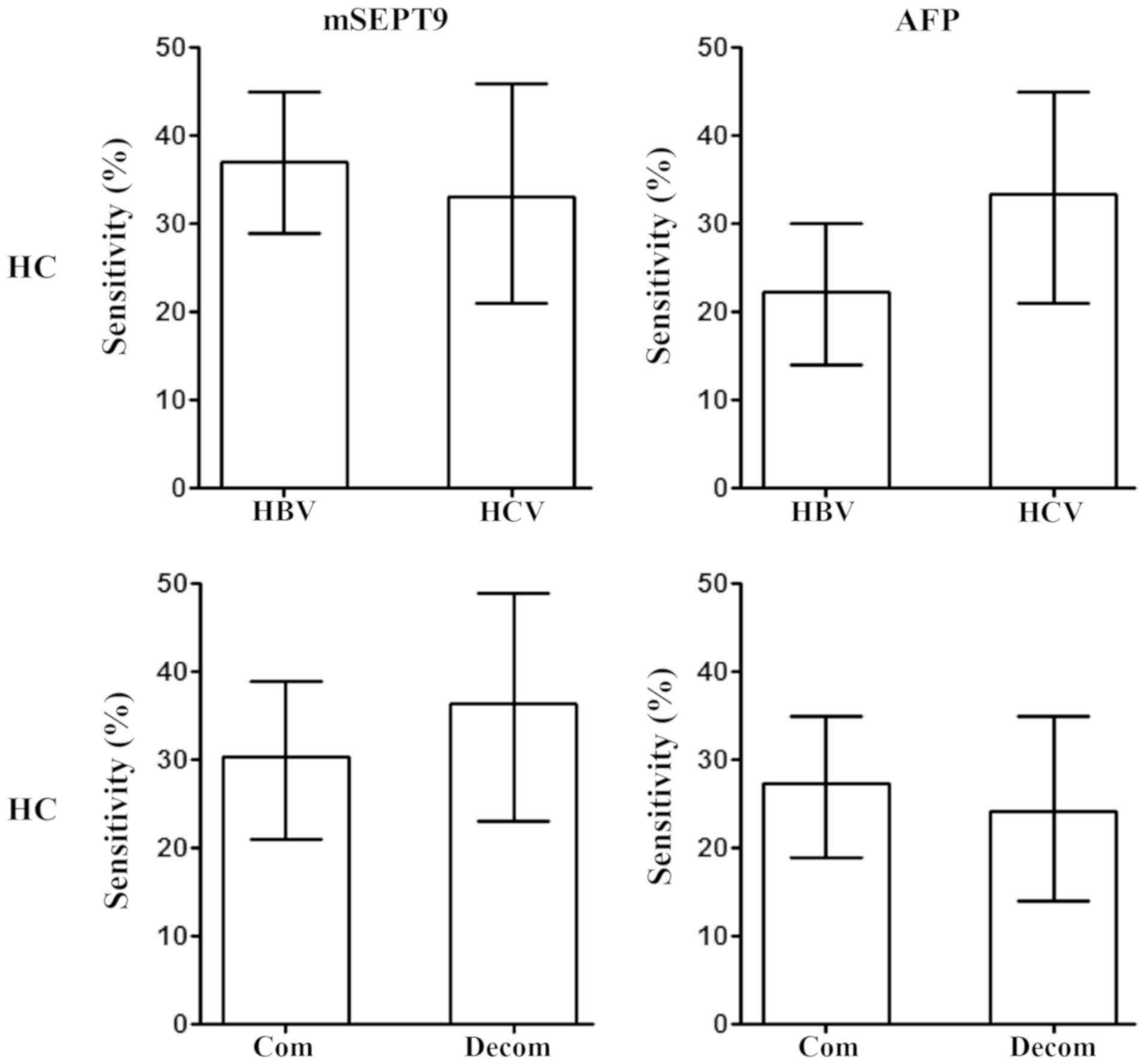|
1
|
Chen W, Zheng R, Baade PD, Zhang S, Zeng
H, Bray F, Jemal A, Yu XQ and He J: Cancer statistics in China,
2015. CA Cancer J Clin. 66:2705–132. 2016. View Article : Google Scholar
|
|
2
|
Hung CH, Lu SN, Wang JH, Lee CM, Chen TM,
Tung HD, Chen CH, Huang WS and Changchien CS: Correlation between
ultrasonographic and pathologic diagnoses of hepatitis B and C
virus-related cirrhosis. J Gastroenterol. 38:153–157. 2003.
View Article : Google Scholar : PubMed/NCBI
|
|
3
|
Karhunen PJ and Penttilä A: Preneoplastic
lesions of human liver. Hepatogastroenterology. 34:10–15.
1987.PubMed/NCBI
|
|
4
|
Alberti A, Chemello L and Benvegnù L:
Natural history of hepatitis C. J Hepatol. 1 (Suppl 31):S17–S24.
1999. View Article : Google Scholar
|
|
5
|
Lyu X, Liu K, Chen Y, Wang Z, Yao J, Cai
G, Jiang Z, Wang Z, Jiang J and Gu H: Analysis of risk factors
associated with the development of hepatocellular carcinoma in
chronic HBV-infected Chinese: A meta-analysis. Int J Environ Res
Public Health. 13:6042016. View Article : Google Scholar
|
|
6
|
Song L, Jia J, Peng X, Xiao W and Li Y:
The performance of the SEPT9 gene methylation assay and a
comparison with other CRC screening tests: A meta-analysis. Sci
Rep. 7:30322017. View Article : Google Scholar : PubMed/NCBI
|
|
7
|
Song L and Li Y: Progress on the clinical
application of the SEPT9 gene methylation assay in the past 5
years. Biomark Med. 11:415–418. 2017. View Article : Google Scholar : PubMed/NCBI
|
|
8
|
Song L, Li Y, Jia J, Zhou G, Wang J, Kang
Q, Jin P, Sheng J, Cai G, Cai S and Han X: Algorithm optimization
in methylation detection with multiple RT-qPCR. PLoS One.
11:e01633332016. View Article : Google Scholar : PubMed/NCBI
|
|
9
|
Wu D, Zhou G, Jin P, Zhu J, Li S, Wu Q,
Wang G, Sheng J, Wang J, Song L, et al: Detection of colorectal
cancer using a simplified SEPT9 gene methylation assay is a
reliable method for opportunistic screening. J Mol Diagn.
18:535–545. 2016. View Article : Google Scholar : PubMed/NCBI
|
|
10
|
Song L, Jia J, Yu H, Peng X, Xiao W, Gong
Y, Zhou G, Han X and Li Y: The performance of the mSEPT9 assay is
influenced by algorithm, cancer stage and age, but not sex and
cancer location. J Cancer Res Clin Oncol. 143:1093–1101. 2017.
View Article : Google Scholar : PubMed/NCBI
|
|
11
|
Dietrich D, Jung M, Puetzer S, Leisse A,
Holmes EE, Meller S, Uhl B, Schatz P, Ivascu C and Kristiansen G:
Diagnostic and prognostic value of SHOX2 and SEPT9 DNA methylation
and cytology in benign, paramalignant and malignant pleural
effusions. PLoS One. 8:e842252013. View Article : Google Scholar : PubMed/NCBI
|
|
12
|
Powrózek T, Krawczyk P, Kucharczyk T and
Milanowski J: Septin 9 promoter region methylation in free
circulating DNA-potential role in noninvasive diagnosis of lung
cancer: Preliminary report. Med Oncol. 31:9172014. View Article : Google Scholar : PubMed/NCBI
|
|
13
|
Oussalah A, Rischer S, Bensenane M, Conroy
G, Filhine-Tresarrieu P, Debard R, Forest-Tramoy D, Josse T,
Reinicke D, Garcia M, et al: Plasma mSEPT9: A novel circulating
cell-free DNA-based epigenetic biomarker to diagnose hepatocellular
carcinoma. EBioMedicine. 30:138–147. 2018. View Article : Google Scholar : PubMed/NCBI
|
|
14
|
Bruix J and Sherman M; Practice Guidelines
Committee, : American Association for the Study of Liver Diseases:
Management of hepatocellular carcinoma. Hepatology. 42:1208–1236.
2005. View Article : Google Scholar : PubMed/NCBI
|
|
15
|
DAmico G, Morabito A, DAmico M, Pasta L,
Malizia G, Rebora P and Valsecchi MG: New concepts on the clinical
course and stratification of compensated and decompensated
cirrhosis. Hepatol Int. 12 (Suppl 1):S34–S43. 2018. View Article : Google Scholar
|
|
16
|
Livak KJ and Schmittgen TD: Analysis of
relative gene expression data using real-time quantitative PCR and
the 2(-Delta Delta C(T)) method. Methods. 25:402–408. 2001.
View Article : Google Scholar : PubMed/NCBI
|
|
17
|
Church TR, Wandell M, Lofton-Day C, Mongin
SJ, Burger M, Payne SR, Castaños-Vélez E, Blumenstein BA, Rösch T,
Osborn N, et al: Prospective evaluation of methylated SEPT9 in
plasma for detection of asymptomatic colorectal cancer. Gut.
63:317–325. 2014. View Article : Google Scholar : PubMed/NCBI
|
|
18
|
Song L, Peng X, Li Y, Xiao W, Jia J, Dong
C, Gong Y, Zhou G and Han X: The SEPT9 gene methylation assay is
capable of detecting colorectal adenoma in opportunistic screening.
Epigenomics. 9:599–610. 2017. View Article : Google Scholar : PubMed/NCBI
|
|
19
|
Song L, Wang J, Wang H, Chen Y, Jia J, Guo
S, Liu H, Peng X, Xiao W, Gong Y, et al: The quantitative profiling
of blood mSEPT9 determines the detection performance on colorectal
tumors. Epigenomics. 10:1569–1583. 2018. View Article : Google Scholar : PubMed/NCBI
|
|
20
|
Song L, Guo S, Wang J, Peng X, Jia J, Gong
Y, Yang B, Xiao W, Dong C, Liu H and Li Y: The blood mSEPT9 is
capable of assessing the surgical therapeutic effect and the
prognosis of colorectal cancer. Biomark Med. 12:961–973. 2018.
View Article : Google Scholar : PubMed/NCBI
|
|
21
|
Kulis M, Merkel A, Heath S, Queirós AC,
Schuyler RP, Castellano G, Beekman R, Raineri E, Esteve A, Clot G,
et al: Whole-genome fingerprint of the DNA methylome during human B
cell differentiation. Nat Genet. 47:746–756. 2015. View Article : Google Scholar : PubMed/NCBI
|
|
22
|
Issa JP: Aging and epigenetic drift: A
vicious cycle. J Clin Invest. 124:24–29. 2014. View Article : Google Scholar : PubMed/NCBI
|
|
23
|
Teschendorff AE, Menon U, Gentry-Maharaj
A, Ramus SJ, Weisenberger DJ, Shen H, Campan M, Noushmehr H, Bell
CG, Maxwell AP, et al: Age-dependent DNA methylation of genes that
are suppressed in stem cells is a hallmark of cancer. Genome Res.
20:440–446. 2010. View Article : Google Scholar : PubMed/NCBI
|
|
24
|
Maegawa S, Hinkal G, Kim HS, Shen L, Zhang
L, Zhang J, Zhang N, Liang S, Donehower LA and Issa JP: Widespread
and tissue specific age-related DNA methylation changes in mice.
Genome Res. 20:332–340. 2010. View Article : Google Scholar : PubMed/NCBI
|
|
25
|
Nagato Y, Kondo F, Kondo Y, Ebara M and
Ohto M: Histological and morphometrical indicators for a biopsy
diagnosis of well-differentiated hepatocellular carcinoma.
Hepatology. 14:473–478. 1991. View Article : Google Scholar : PubMed/NCBI
|
|
26
|
Peng X, Liu X, Xu L, Li Y, Wang H, Song L
and Xiao W: The mSHOX2 is capable of assessing the therapeutic
effect and predicting the prognosis of stage IV lung cancer. J
Thorac Dis. 11:2458–2469. 2019. View Article : Google Scholar : PubMed/NCBI
|
|
27
|
Bai DS, Zhang C, Chen P, Jin SJ and Jiang
GQ: The prognostic correlation of AFP level at diagnosis with
pathological grade, progression, and survival of patients with
hepatocellular carcinoma. Sci Rep. 7:128702017. View Article : Google Scholar : PubMed/NCBI
|
|
28
|
Chan MY, She WH, Dai WC, Tsang SHY, Chok
KSH, Chan ACY, Fung J, Lo CM and Cheung TT: Prognostic value of
preoperative alpha-fetoprotein (AFP) level in patients receiving
curative hepatectomy-an analysis of 1,182 patients in Hong Kong.
Transl Gastroenterol Hepatol. 4:522019. View Article : Google Scholar : PubMed/NCBI
|
|
29
|
Aoyagi Y, Oguro M, Yanagi M, Mita Y, Suda
T, Suzuki Y, Hata K, Ichii K and Asakura H: Clinical significance
of simultaneous determinations of alpha-fetoprotein and
des-gamma-carboxy prothrombin in monitoring recurrence in patients
with hepatocellular carcinoma. Cancer. 77:1781–1786. 1996.
View Article : Google Scholar : PubMed/NCBI
|
|
30
|
Potter NT, Hurban P, White MN, Whitlock
KD, Lofton-Day CE, Tetzner R, Koenig T, Quigley NB and Weiss G:
Validation of a real-time PCR-based qualitative assay for the
detection of methylated SEPT9 DNA in human plasma. Clin Chem.
60:1183–1191. 2014. View Article : Google Scholar : PubMed/NCBI
|
|
31
|
Ravegnini G, Zolezzi Moraga JM, Maffei F,
Musti M, Zenesini C, Simeon V, Sammarini G, Festi D, Hrelia P and
Angelini S: Analysis of SEPT9 promoter methylation status,
micronuclei frequency, and folate-related gene polymorphisms: The
potential for a novel blood-based colorectal cancer biomarker. Int
J Mol Sci. 16:28486–28497. 2015. View Article : Google Scholar : PubMed/NCBI
|















